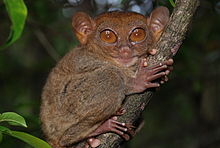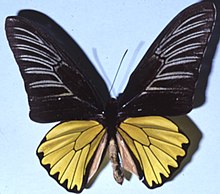Wildlife of the Philippines

Thewildlife of the Philippinesincludes a significant number ofendemicplantandanimalspecies. The country's surrounding waters reportedly[1]have the highest level of marine biodiversity in the world. The Philippines is one of the seventeenmegadiverse countriesand is a globalbiodiversity hotspot.In 2013, 700 of the country's 52,177 species were listed asthreatened.[2]
The Philippines has among the highest rates of species discovery in the world with 16 new species of mammal discovered in the last ten years. Because of this, the degree of endemism in the Philippines has risen and will likely continue to rise.[3]
Some of the smallest and largest animals and plants are found in the Philippines. These include the smallest primate (tarsier), the biggest moth (Atlas moth,ormariposain Tagalog), the smallest deer (Philippine mouse-deerorpilandok), the smallest fish (Philippine goby), and the biggest fish (whale shark).[4]
Birds[edit]


There are 714 species of birds in the Philippines, of which243are endemic, three have been introduced by humans, and 52 are rare or accidental occurrences. The Philippines has the third-highest number of endemic birds, behind the much larger countries ofAustraliaandIndonesia.There are 67 globally threatened species, including therufous hornbilland the critically endangered national bird of the Philippines, thePhilippine eagleor monkey-eating eagle. Until 1995, the national bird of the Philippines was themaya(which, in the Philippines, refers to a variety of small, commonly observed passerine bird).[citation needed]The Philippines is also home toTawi-Tawi'sblue-winged racket-tail,the most endangered parrot species in Southeast Asia, theSulu hornbill,one of the most endangered animals in the world with a population of just 27, and theCalayan rail,the most endangered species of rail in the world, found only on a small island in theBabuyan Islands.[5]
According to the EDGE of Existence Programme of theZoological Society of London,the Philippines has the highest level of birdendemismin the world. Six of the world's 50 most evolutionary distinct and globally endangered (EDGE) species are found in the Philippines. These species are thePhilippine eagle(15th place, the highest from the Philippines),spoon-billed sandpiper(#19),black-hooded coucal(#22),Sulu hornbill(#41),Cebu brown-dove(#46), andrufous-headed hornbill(#50). Previously, in 2013, when the list was up to 100, the various bleeding heart dove species, found only in the Philippines, and thePhilippine cockatoowere also on the list.[6]
Amphibians and reptiles[edit]
There are more than 111 species of amphibian and 270 species of reptile in the Philippines, of which 80% and 70% are endemic, respectively.[7]Of the 114 species of snake, it is thought that no more than 14 are venomous. Several species of reptiles and amphibians remains undescribed. The Philippines also has 50–60 endemicPlatymantisfrog species, making it by far the most diverse genus of amphibians in the archipelago.[8]
The endemic freshwater crocodileCrocodylus mindorensisis critically endangered and is considered the most threatened crocodilian in the world. In 1982, wild populations were estimated to be only 500–1,000 individuals; by 1995 a mere 100 crocodiles remained living in the wild. The recent discovery of a population of this species in the Sierra Madre mountains of Luzon brings new hope for its conservation. Projects are being conducted in an effort to save the crocodiles. The Crocodile Rehabilitation, Observance and Conservation (CROC) Project of the Mabuwaya Foundation is active in carrying out such projects.
Other threatened reptiles includeGray's monitorand thePhilippine forest turtle.Of the three species offrugivorousmonitor lizards globally, two occur in the Philippines: thePanay monitor lizardfrom the island ofPanayandNorthern Sierra Madre forest monitorfrom north east Luzon.
Marine animals[edit]
Among the seas of the Philippines' 7,107 islands there is great diversity of marine animals.Butanding,orwhale shark,the largest fish, can be found in the province ofSorsogon.Thedwarf pygmy gobyor Philippine goby (Pandaca pygmaea), is one of the shortest and lightest freshwater fish in the world with a size of 9-11 mm; about the size of a grain of rice. Themilkfishorbangus(Chanos chanos), can also be found in oceans and can be cultivated in freshwater of Hagonoy, Bulacan, and other provinces.[9]Yellow-fin tuna, blue marlin, red snapper, swordfish, flying fish, parrot fish, puffer fish, jack, manta ray, and pink salmon are also found in the Philippines. The biggest clam,Tridacna gigas,is found in the Philippines. One of the heaviest bony fish in the world, theocean sunfish(Mola mola), can also be found in the country.
Freshwater fish[edit]
The Philippines has about 330 species of freshwater fish,[10]including nine endemic genera and more than 65 endemic species, many of which are confined to single lakes. An example isSardinella tawilis,a freshwater sardine found only inTaal Lake.Lake Lanao,in Mindanao, seems to be experiencing the country's most catastrophic extinction event, with nearly all of the lake's endemic fish species now almost certainly extinct, primarily due to the introduction oftilapiafor the expansion of the fishing industry. Other exotic species were also introduced to the lake.[3]
Insects and other invertebrates[edit]

About 70% of the Philippines' nearly 21,000 recorded insect species are found only in the country. In addition, about one-third of the 915 butterflies found here are endemic to the country, and over 110 of the more than 130 species oftiger beetleare found nowhere else. One of the largest butterflies in the world and the largest in the Philippines, theMagellan birdwing,can be found here. The largest moth, theAtlas moth,can also be found in the Philippines.[3]

Crustaceans are very diverse in the archipelago. More than 50 species offreshwater crabs(in the generaCarpomon,Insulamon,Isolapotamon,Mainitia,Mindoron,Ovitamon,Parathelphusa,andSundathelphusa) are known from the Philippines and all are endemic to the country.[11]
Flora[edit]
See also[edit]
- List of extinct animals of the Philippines
- List of threatened species of the Philippines
- List of non-marine molluscs of the Philippines
- List of endemic birds of the Philippines
- List of mammals of the Philippines
- Environmental issues in the Philippines
- Wildlife of Palawan
References[edit]
- ^Carpenter, K.E. and V.G. Springer. 2005. Environmental Biology of Fishes (2005) 72: 467–480.
- ^OECD Food and Agricultural Reviews Agricultural Policies in the Philippines.OECD Publishing.April 7, 2017.ISBN978-92-64-26908-8.RetrievedApril 20,2023.
- ^abcConservation International."Biological diversity in the Philippines".RetrievedMarch 17,2015.
- ^Biology for Non-Science Majors.1983.ISBN9789712314452.
- ^Allen, Desmond.Birds of the Philippines.
- ^"Species".EDGE of Existence.
- ^Brown M. R.., Siler D.C.. Oliveros H.C.. Esselstyn A.J..Diesmos C. A.. Hosner A. P.. Linkem W. C.. Barley J. A.. Oaks R. J.. Sanguila B. M.. Welton J. L.. Blackburn C. D.. Moyle G. R.. Peterson T. A.. Alcala C. A.. 2013.Evolutionary Processes of Diversification in a Model Island Archipelago(pdf). TheAnnual Review of Ecology, Evolution, and Systematics.Vol.44. pp.411–35.doi:10.1146/annurev-ecolsys-110411-160323.Retrieved on April 14, 2017
- ^Brown, R. M., Siler, C. D., Richards, S. J., Diesmos, A. C. and Cannatella, D. C. (2015), Multilocus phylogeny and a new classification for Southeast Asian and Melanesian forest frogs (family Ceratobatrachidae). Zool J Linn Soc, 174: 130–168.doi:10.1111/zoj.12232
- ^Medenilla, Vina (May 19, 2022)."A primer on bangus".Manila Bulletin.
- ^Nguyen, T.T.T., and S. S. De Silva (2006).Freshwater finfish biodiversity and conservation: an Asian perspective.Biodiversity & Conservation 15(11): 3543–3568
- ^Mendoza, Jose Christopher E.; Darren C.J. Yeo (2014). "A new species of Isolapotamon Bott, 1968 (Decapoda, Brachyura, Potamidae) from Mindanao, with notes on the Philippine Isolapotamon species". In Yeo, Darren C.J.; Neil Cumberlidge; Sebastian Klaus (eds.).Advances in Freshwater Decapod Systematics and Biology, Crustaceana Monographs.Vol. 19. pp. 135–159.doi:10.1163/9789004207615_009.ISBN9789004207615.
External links[edit]
- "The National Invasive Species Strategy and Action Plan 2016-2026"(PDF).Department of Environment and Natural Resources-Biodiversity Management Bureau. 2016.
